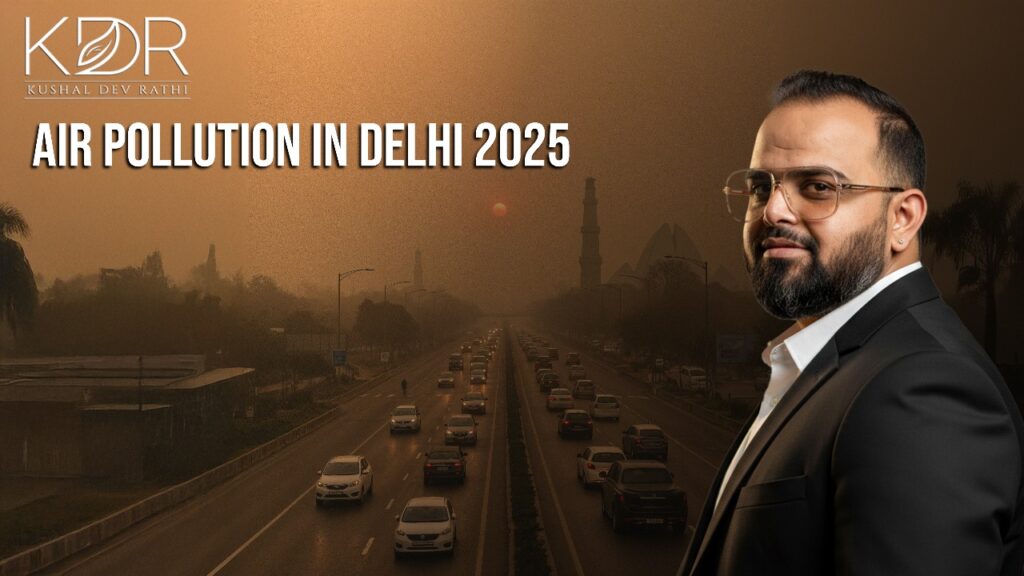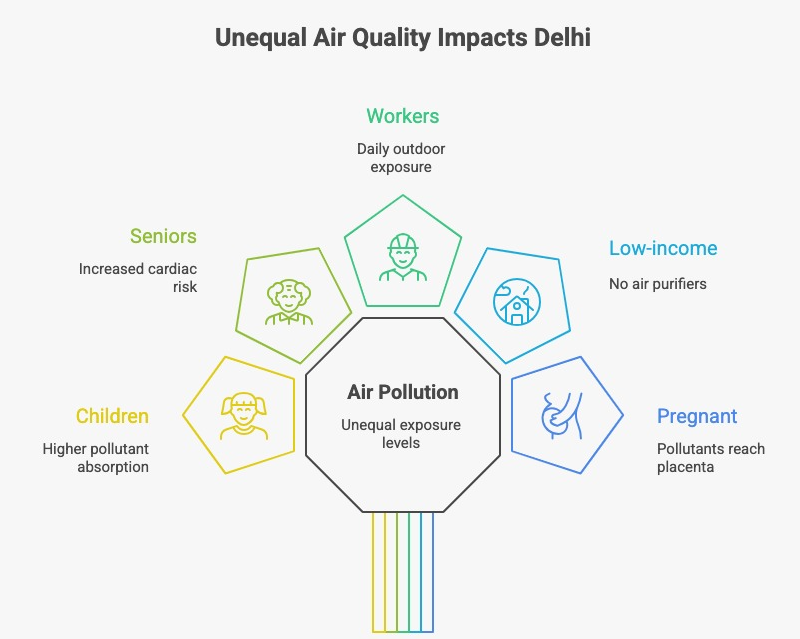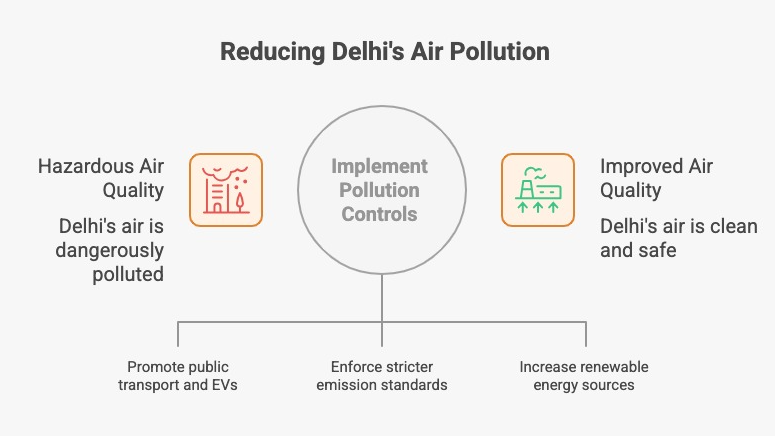Table of Contents
ToggleThe Sky That Wouldn’t Lift: How Air Pollution in Delhi Redefined Land, Life, and Survival
THE MORNING WHEN THE SKY GREW HEAVIER THAN TRUTH
The morning of 22 November 2025 began like a confession.
Not the kind spoken aloud.
The kind whispered by land.
By air.
By the soil itself.
When I stepped out to breathe, the city refused to let me.
A burnt-orange glow smudged itself across the horizon. The sky didn’t look like dawn. It looked like a warning. It looked like the city was slowly suffocating and still pretending to go to work on time.
I opened my window, and the air felt… dense.
Dense with smoke.
Dense with chemicals.
Dense with a truth Delhi has been trying to outrun for decades.
On 22 November, Delhi’s average AQI hovered around 364–400, with multiple stations breaching 425–445. Mundka touched 442, Jahangirpuri and Bawana touched 428–429.
This wasn’t weather.
This wasn’t haze.
This was air pollution in Delhi in its most honest form.
But numbers rarely capture reality.
Breath does.
And on this morning, every breath told me the same thing:
We are inhaling the future we are creating.
THE DAY DELHI STOPPED BREATHING — 22 NOVEMBER AQI, UNFILTERED
I’ve lived long enough with land to recognise a pattern before the world calls it one. I’ve watched soil crack, rivers thin, hills erode, forests whisper their losses.
And I’ve watched Delhi’s sky follow the same trajectory as its soil.
On 22 November:
- The average AQI was in the “very poor” to “severe” zone.
- PM2.5 peaked to 280–300 µg/m³ in several pockets — nearly 20 times India’s allowable standard and 100 times the WHO’s safe limit.
- Over 16 days out of 21 in November, Delhi remained in the “very poor” category.
What shocked me was not the number.
It was how normal it felt.
That is the tragedy of air pollution in Delhi — the normalization of slow, invisible violence.
We’ve turned toxic air into an annual routine:
- Standstill winds in November
- Inversion layers trapping pollutants
- High traffic density
- Construction dust
- Industrial emissions across NCR
- Degraded soil turning into airborne dust
- Stubble burning drifting down from Punjab & Haryana
These forces come together like clockwork — the Calendar of Choking, I often call it.
And Delhi follows its cruel rhythm:
September: humidity traps pollutants
October: stubble burning begins
November: winds disappear
December: inversion peaks
January: fog + trapped PM2.5
February: mild relief
March–August: the only months the city can pretend it’s breathing
This is not a season.
This is a system.
And on 22 November, that system tightened its grip.
“IF YOU CAN LEAVE, LEAVE.” — THE MOST HONEST MEDICAL ADVICE OF OUR TIME
There is one sentence that has echoed more loudly than any policy announcement:
“If you can leave Delhi for a month… leave.”
Doctors from AIIMS, Fortis, Max, SGR — all saying the same thing.
I’ve spoken to pulmonologists who say:
- Children are inhaling toxic air equal to 20–25 cigarettes/day
- Seniors show sudden drops in oxygen saturation
- Cardiac patients face heightened stroke risk
- Pregnant women are experiencing pollutant transfer to the placenta
- Teenagers show early signs of reduced lung elasticity
A doctor friend told me,
“Kushal, this is not an air crisis. This is a population-level lung injury.”
But here’s the truth I’ve learned walking through both forested lands and concrete cities:
Most people cannot leave.
The privilege of clean air is becoming the new class divide.
THERE ARE THREE TYPES OF PEOPLE IN DELHI:
1. Those who can leave
They get into cars, drive to Himachal, Uttarakhand, Goa.
Their lungs reset.
2. Those who can sometimes leave
People like me, who work remotely, run businesses, or have farm retreats.
We oscillate between survival and responsibility.
3. Those who cannot leave
The largest group — the backbone of the city.
Drivers. Teachers. Students. Retail workers. Small businesses. Delivery agents. Security guards.
People who inhale Delhi because they must live in Delhi.
For them, air pollution in Delhi is not a headline.
It is their morning breakfast, afternoon fatigue, evening breathlessness, night-time cough.
It is the city entering their lungs faster than opportunity enters their lives.
THE CRUEL SCIENCE OF WHAT WE ARE BREATHING
I’ve never been intimidated by data.
I’ve been intimidated by what the data means for human life.
On 22 November, Delhi inhaled:
PM2.5 — The assassin you cannot see
These ultra-fine particles seep into:
your lungs
your bloodstream
your heart
your brain
even foetal tissue
They are microscopic violence.
PM10 — The dust of broken land
This is where soil degradation becomes air degradation.
When soil dries, cracks, erodes — it becomes PM10.
And with enough friction, PM10 becomes PM2.5.
NO₂ & SO₂ — The respiratory trigger duo
Produced by vehicles, industrial combustion, and power plants.
Ground-level ozone — The unexpected enemy
Created when sunlight reacts with pollutants.
Not visible.
But dangerous.
Black carbon — The residue of our rush
From diesel, biomass, and unregulated combustion.
The (CPCB Dashboard) looked like a battlefield.
But here’s the real problem:
The body doesn’t forget.
It stores every breath.
It remembers every winter.
It accumulates every microgram.
THE PEOPLE TRAPPED INSIDE THE CITY’S AIR-CAGE
I want to speak directly about this, without filters.
When I work with land, I ask:
Who does this land serve?
Who will it protect?
Who will it fail?
In Delhi’s case, here is the brutal truth:
Children suffer first.
Small airways + high breathing rate = maximum absorption.
Seniors suffer silently.
Their lungs do not regenerate.
Outdoor workers are the city’s frontline victims.
Delivery riders
Hawkers
Cab drivers
Traffic police
Construction workers
They breathe for 10–14 hours outdoors.
Low-income households suffer disproportionately
No purifiers
No insulation
No alternate home
No financial cushion
Women suffer uniquely
Indoor pollution doubles during winter.
Outdoor hazard adds a second layer.
Students suffer invisibly
Brain fog
Fatigue
Reduced cognitive performance
Long-term anxiety patterns
And so the question becomes:
When air becomes privilege, what becomes of equality?
WHAT 22 NOV TELLS US ABOUT OUR NEXT 10 YEARS
I’ll say it plainly, because real estate and land development without honesty is just commerce:
If the current trajectory continues, Delhi will be the world’s least breathable mega-city by 2035.
Here is the future Delhi is walking toward:
1. A 6-month pollution season
September to February — half the year in toxic air.
2. Annual public health emergencies
Smog clinics, emergency wards overflowing, increased mortality.
3. Real estate stagnation in high-pollution corridors
Air quality will become a price determinant.
4. Mass micro-migration
Not large exodus — but waves of seasonal escape.
5. Children’s lung capacity falling permanently
A weak generation, not by genetics but by geography.
6. Land value divergence
Land surrounded by clean air, soil, and tree cover will become the new gold.
7. Regulatory pressure on builders
Stricter environmental norms, higher compliance cost, delayed construction.
8. A psychological shift
Families will plan life differently:
School timings
Work-from-home strategies
Seasonal relocation
Land ownership in clean territories
9. Climate making it worse
Hotter summers → more dust storms
Warmer winters → tighter inversion layers
Irregular rain → fewer cleansing cycles
10. Soil degradation intensifying air pollution
Because land and air are not separate systems.
They are one conversation.
SECOND HOMES & CLEAN-AIR MIGRATION — THE QUIET REVOLUTION
I never set out to build luxury.
I set out to build sanctuaries.
Spaces where land still remembers how to breathe.
But something changed over the last four years.
When families call me now, they say things like:
“My son can’t inhale this air anymore.”
“My father’s heart condition gets worse every November.”
“My daughter’s cough doesn’t go away.”
“We need somewhere to escape during winter.”
The second home is no longer a holiday idea.
It has become respiratory insurance.
Why second homes matter in this crisis:
1. Temporary relocation saves lungs
Two weeks in clean environments reverse inflammation.
2. Children’s bodies recover faster
Their lungs expand, oxygenation improves, sleep resets.
3. Productivity rises
Foggy thinking, fatigue, emotional irritability — all drop in fresh-air zones.
4. Medical dependency lowers
Fewer inhalers, fewer emergency visits.
5. Mental health rebalances
Because clean air is not just oxygen.
It is clarity.
6. Long-term wealth grows
Regions with forests, soil health, and wind corridors will flourish.
The new migration map looks like this:
Sariska
Chail
Kufri
Binsar
Naukuchiatal
Goa interiors
Western Ghats
Aravalli foothills
These are no longer travel spots.
They are breathing corridors.
LAND IS WHERE THIS ENTIRE STORY BEGINS — AND WHERE IT WILL END
I say this not as a developer, but as someone shaped by soil:
Air pollution in Delhi is not an air problem.
It is a land problem.
Look beneath the smog:
- Degraded soil becomes airborne dust
- Dead trees remove natural filters
- Broken Aravalli ridges allow desert winds to enter
- Urban heat islands intensify PM concentration
- Wetlands lost → no natural cleansing
- Overbuilt surfaces → no wind flow
I’ve walked through lands in Sariska where the wind still carries purity.
Through forest corridors in Chail where mornings are crisp.
Through villages in Goa where trees stand like guardians of life.
All these places taught me the same truth:
The air is just the messenger.
The land is the message.
If soil collapses, air collapses.
If forests collapse, lungs collapse.
If water systems collapse, immunity collapses.
If land loses its breath, cities lose their future.
WHAT INDIA MUST FIX — A LAND-FIRST FRAMEWORK
If we truly want to heal air pollution in Delhi, here is what we must do:
1. Restore soil health
Mulching
Agroforestry
Wetlands
Forest corridors
2. Protect the Aravalli range
Our natural wind barrier.
Our natural dust filter.
3. Reforest Delhi like a medicine
Native species
Continuous canopy
Urban forest pockets
4. Regulate construction dust more strictly
Fine dust = PM10 = PM2.5
5. Create planned breathing corridors
Green highways
Wind channels
No-construction strips
6. Respect the land’s carrying capacity
Not everything can be concretised.
7. Decentralise growth
Let smaller towns breathe life.
8. Teach land literacy
Children should understand soil before stock markets.
FAQ
1. Why is air pollution in Delhi so severe every winter?
Combination of meteorology, emissions, soil degradation, stubble burning, and high urban density.
2. What was the AQI on 22 November 2025?
Citywide ~364–400, hotspots 428–445.
3. Are doctors advising relocation due to air pollution in Delhi?
Yes. They advise vulnerable groups to temporarily relocate.
4. Which areas suffer the most from air pollution in Delhi?
High-traffic zones, industrial belts, densely populated neighbourhoods.
5. Can children recover lung capacity after breathing Delhi’s air?
Partial recovery is possible with extended exposure to clean air.
6. Which regions provide refuge from air pollution in Delhi?
Sariska, Uttarakhand, Himachal, Goa interiors.
7. How is soil linked to air pollution in Delhi?
Degraded soil → dust → PM10 → PM2.5.
8. Will air pollution in Delhi worsen over the next decade?
Yes, unless land-first action begins immediately.
9. Are air purifiers enough?
They help indoors but cannot replace outdoor clean air systems.
10. Can land investment protect families from air pollution in Delhi?
Yes — land with natural vegetation, altitude, or forest adjacency acts as a wellness buffer.
THE LAND REMEMBERS WHAT WE FORGET
Standing in the forests of Sariska last week, I watched the wind move through the trees like a prayer. And I realised something profound:
Cities chase speed.
Land chases balance.
Air carries the consequences of both.
Delhi’s air is telling us a truth we’ve ignored for too long:
We cannot heal the sky until we heal the soil.
We cannot protect our lungs until we protect the land.
We cannot build a future if the future cannot breathe.
On 22 November, Delhi didn’t just choke.
It reminded us that breath is borrowed — from land, from forests, from ecosystems smarter than us.
My message is simple:
Choose land that breathes.
Choose soil that regenerates.
Choose spaces where your children can inhale their own future.
Because the land remembers.
The air reveals.
And legacy is built only where life can breathe.




